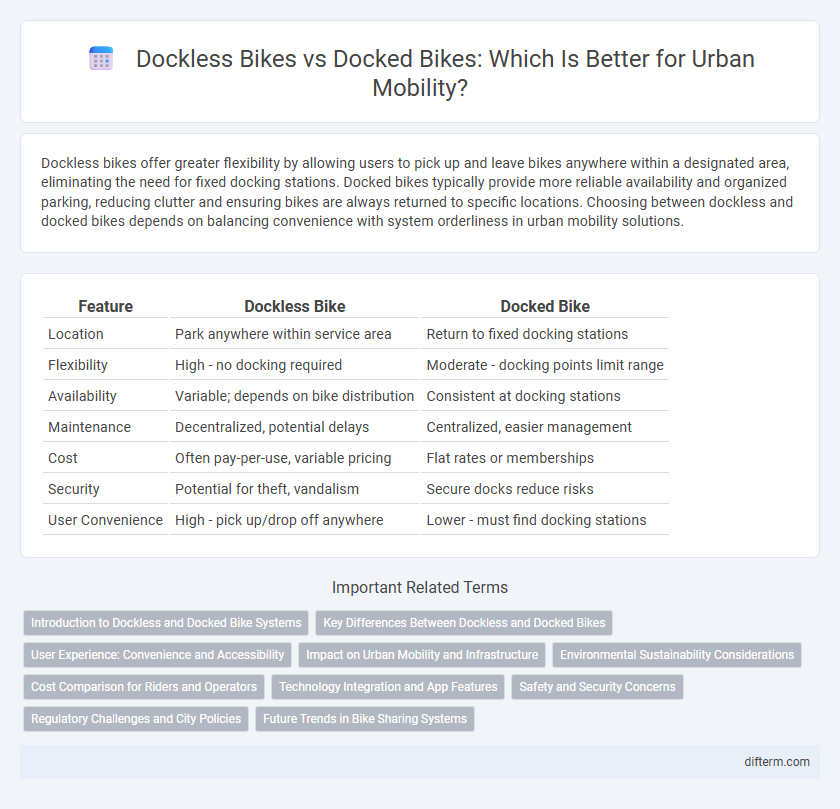Dockless bikes offer greater flexibility by allowing users to pick up and leave bikes anywhere within a designated area, eliminating the need for fixed docking stations. Docked bikes typically provide more reliable availability and organized parking, reducing clutter and ensuring bikes are always returned to specific locations. Choosing between dockless and docked bikes depends on balancing convenience with system orderliness in urban mobility solutions.
Table of Comparison
| Feature | Dockless Bike | Docked Bike |
|---|---|---|
| Location | Park anywhere within service area | Return to fixed docking stations |
| Flexibility | High - no docking required | Moderate - docking points limit range |
| Availability | Variable; depends on bike distribution | Consistent at docking stations |
| Maintenance | Decentralized, potential delays | Centralized, easier management |
| Cost | Often pay-per-use, variable pricing | Flat rates or memberships |
| Security | Potential for theft, vandalism | Secure docks reduce risks |
| User Convenience | High - pick up/drop off anywhere | Lower - must find docking stations |
Introduction to Dockless and Docked Bike Systems
Dockless bike systems enable users to locate and unlock bicycles via mobile apps, offering flexible pick-up and drop-off locations without fixed stations, enhancing last-mile connectivity in urban mobility. Docked bike systems rely on designated docking stations, providing structured parking and typically greater bike availability, ensuring organized fleet management and reduced street clutter. Both systems cater to diverse commuter needs by balancing convenience, accessibility, and operational efficiency within shared mobility frameworks.
Key Differences Between Dockless and Docked Bikes
Dockless bikes offer flexible pick-up and drop-off locations enabled by GPS tracking and smartphone apps, eliminating the need for fixed stations, while docked bikes require designated docking stations for rental and return. Dockless systems often experience higher instances of bike misplacement and vandalism, contrasted with the structured and secure environment of docked bikes. Cost models vary; dockless bikes typically feature per-minute charges with no station fees, whereas docked bikes usually implement fixed rental fees and time-based pricing tied to docking infrastructure.
User Experience: Convenience and Accessibility
Dockless bikes offer unmatched convenience by allowing users to pick up and leave bikes anywhere within a designated area, eliminating the need to locate fixed docking stations. Docked bikes, while more reliable in terms of availability at set points, restrict flexibility and may require longer walks to access or return. User accessibility improves significantly with dockless systems due to GPS-enabled tracking and app integration, facilitating seamless, on-demand mobility in urban environments.
Impact on Urban Mobility and Infrastructure
Dockless bikes enhance urban mobility by providing flexible, on-demand transportation that reduces reliance on personal vehicles and improves first-and-last-mile connectivity. However, they pose challenges to urban infrastructure, including cluttered sidewalks and increased maintenance costs for municipalities. In contrast, docked bike systems offer organized parking that integrates with existing transit hubs but may limit accessibility due to fixed station locations.
Environmental Sustainability Considerations
Dockless bikes reduce the need for fixed infrastructure, lowering urban space consumption and enabling flexible redistribution, which can minimize environmental impact compared to docked systems. However, dockless systems often face challenges with bike clutter and higher rates of vandalism or disposal, potentially increasing waste and resource inefficiency. Docked bikes generally promote organized usage and longer bike lifecycle, contributing to more sustainable urban mobility by reducing environmental footprint through enhanced resource management.
Cost Comparison for Riders and Operators
Dockless bikes typically offer lower upfront costs for riders due to pay-as-you-go pricing, while docked bikes require higher subscription fees but provide consistent availability. Operators of dockless bike systems face increased expenses in bike redistribution, maintenance, and theft prevention compared to docked systems, which demand significant investment in docking infrastructure but benefit from centralized asset management. Cost efficiency for operators hinges on balancing operational logistics with user convenience to optimize fleet utilization and revenue.
Technology Integration and App Features
Dockless bikes leverage GPS and IoT technology for real-time tracking and flexible parking, enhancing user convenience through app features like instant unlocking and route optimization. Docked bikes integrate with fixed stations using smart locks and NFC, supporting secure rentals and easy bike returns, often coupled with payment and membership management in their apps. Both systems utilize advanced mobile interfaces, but dockless solutions prioritize seamless location-based services while docked models focus on station availability and maintenance updates.
Safety and Security Concerns
Dockless bikes often raise safety and security concerns due to their unpredictable parking locations, increasing the risk of accidents and vandalism. In contrast, docked bikes benefit from designated stations that enhance organized storage and reduce theft or misuse. The structured environment of docked bike systems typically ensures better compliance with safety standards and facilitates maintenance checks.
Regulatory Challenges and City Policies
Dockless bike systems face regulatory challenges due to concerns over sidewalk clutter, improper parking, and vandalism, requiring cities to implement strict permit requirements and operational guidelines. Docked bike programs benefit from fixed stations that promote orderly parking and easier enforcement but involve higher infrastructure costs and limited flexibility. Urban policies increasingly emphasize comprehensive frameworks that balance user convenience, public safety, and equitable access in micromobility management.
Future Trends in Bike Sharing Systems
Dockless bike sharing systems are expected to dominate future urban mobility due to their flexibility and real-time tracking through GPS integration, enabling seamless user experience without reliance on fixed docking stations. Docked bike programs, while still relevant for structured environments, face limitations in scalability and require significant infrastructure investment, making them less adaptive to rapid urban growth. Emerging trends in mobility emphasize hybrid models combining dockless convenience with designated parking zones to optimize city space management and reduce sidewalk clutter.
dockless bike vs docked bike Infographic

 difterm.com
difterm.com